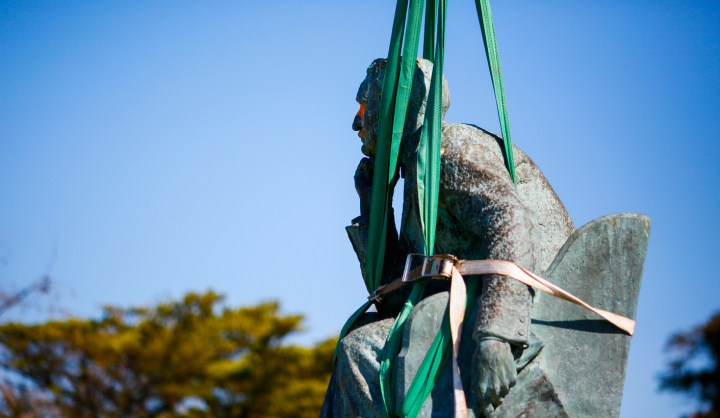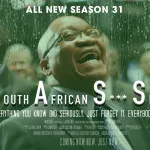South Africa
It’s not about the statues, Stupid!

On Thursday evening, below the dramatic backdrop of Table Mountain, the statue of Cecil John Rhodes rose from its plinth, teetered in mid air, and was then lowered onto a flatbed truck that drove it off to a place of safety. University of Cape Town (UCT) students whipped the statue and covered it in red paint as others cheers and ululated. It was the final moments of ignominy before the statue disappeared from public view. Now there are raging debates about heritage, race and the pace of transformation. But let’s not forget who started this. #RhodesMustFall was driven by the UCT Students Representative Council (SRC) but it is Julius Malema who planted the seed. What this saga has shown is that, politically, nothing is set in stone. By RANJENI MUNUSAMY.
In his maiden address in Parliament last June, Economic Freedom Fighters (EFF) leader Julius Malema introduced a subject that, at the time, appeared to be out of left field. He was responding to President Jacob Zuma’s first State of the Nation Address of the fifth administration and started to pick apart what he called the ANC’s “elite pact” that seeks to protect white minority capital and white privilege.
“This elite pact is reflected by the fact that the most prominent statue in this Parliament is a statue of Louis Botha, and the one of Nelson Mandela is very small and is hidden behind the statue of Louis Botha. Louis Botha is not our hero and cannot be a hero of a democratic South Africa. He is a colonial warmonger, who fought for the exclusion of black and indigenous people from running their own country and affairs.
“It is people like this who made white South Africans think they are superior and if we continue celebrating them, we are equally perpetuating white supremacy. The statue of Botha outside this Parliament must go down, because it represents nothing of what a democratic South Africa stands for,” Malema said. He went on to say: “We must do away with self hate and embrace who we are and what we stand for. The time for black majority to benefit from the natural, mineral and the beauty of their country is now and can never be postponed.”
These sentiments may have been lost in the ensuing media coverage, but not on a generation growing restless with institutions and the country stuck in constructs of the past. The protest action and defacing of colonial statues that began at UCT caught on in other parts of the country because a consciousness has been awakened.
This week, the statue of Louis Botha outside Parliament that Malema spoke of was defaced. This prompted a statement from the office of the ANC chief whip Stone Sizani. “The malicious damage of statues at certain locations in the cover of darkness signifies nothing but cowardice by those seeking to opportunistically piggyback on the publicity generated by the successful campaign led by the progressive students of the University of Cape Town regarding the statue of Cecil Rhodes.
“There’s nothing courageous or heroic by peacetime ‘fighters’ or ‘revolutionaries’ who go around kicking doors that are already open and subverting due processes merely for media attention,” the ANC said.
“The UCT students’ campaign was thus more than just about the statue, but it was significant within the context of a lack of transformation at the institution in the last 20 years. The hooligans, some of whom have shamelessly come out to claim responsibility, are not driven by any rationality or substance, but by a lust for publicity and self-aggrandisement,” the chief whip’s statement said.
The ANC’s flat-footedness on the statue’s debate is mostly because they do not know where to go with it. They appear to condone the action of the UCT students because of the “context of a lack of transformation at the institution” but believe that bringing down or defacing statues elsewhere amounts to “hooliganism and criminality”.
But is the fact that students had to resort to a militant month-long campaign, poo throwing and sit-ins not because the ANC government has let such issues lapse? The UCT students did more than bring down a statue that depicts colonial exploitation and oppression, they have also placed on the agenda issues such as the financial and academic exclusion of black students, and the dearth of black and black female academics at the institution. The ANC cannot choose to deal with transformation in silos, talking it up in business and the media, for example, but letting students lead the way in academia.
The ANC has now taken a hard line on the defacing of colonial and apartheid era statues, condemning those involved and cleaning up after them. But was it not President Jacob Zuma who has spoken repeatedly recently about how South Africa’s problems should be blamed on Jan van Riebeeck, the Dutch colonialist and “founder” of Cape Town?
Would it be acceptable to deface Van Riebeeck’s statues as an expression of frustration with the country’s social and economic problems? Because that is, in fact, what is behind is behind the rage and emotion in our country. Economic hardships, poverty, the lack of jobs, poor housing conditions, corruption, and crime and violence are weighing heavily on the vast majority of South Africans, and these are blamed on historical policies and practices.
What is the outlet? Like with the outbreaks of xenophobia, frustration with being stuck in the poverty trap provokes errant behaviour. The awful truth is that more and more, communities are having to resort to violence to raise their grievances and get the attention of authorities. Government tends to be deaf to complaints and cries for help, unless communities are driven to violent behaviour.
The EFF, as part of its mobilisation campaign, is identifying hot spots in society. Mining communities, the landless and student organisations have all been on their radar. They announced as much after the first meeting of the central command team this year. They said they would be building structures across the country, including in institutions of higher learning, “radical and militant campaigns around all mining communities”, and establish ward-based branches in all municipalities. “The EFF will lead radical and militant land redistribution programme, which will give unoccupied land to landless masses of our people.”
These campaigns are starting to bear fruit. The EFF Student Command has now toppled the ANC-aligned Sasco in SRC elections at two institutions, the University of Limpopo and the Vaal University of Technology. The EFF has also launched a land occupation campaign in areas in Gauteng and the Western Cape.
The EFF has been unapologetic about the activism around the removal of colonial and apartheid monuments. “The EFF has long held the conviction that it is these monuments that continue to inspire white people to think they are superior and have the right to celebrate their murderous and racist past even 21 years after 1994.
“Let all statues fall, together with their legacies of landlessness, racism and poverty,” the EFF said in statement welcoming the decision by UCT to remove the Rhodes statue.
The EFF does not need to physically remove the statues themselves. Their campaign is to shake things up and cause upheaval to the normal cause of business, just like they have successfully done in Parliament. The raging debates now about the lack of transformation, racial legacies and preservation of the status quo are fertile ground for them to mobilise on.
The ANC has caught up too late and is now accusing the EFF of “seeking to opportunistically piggyback on the publicity”. But it cannot stop the debates and engaging in them opens the ANC to criticism on issues of transformation, race and economic exclusion. The ANC’s leadership failures can thus be attacked from quarters they do not expect.
There is deep symbolism and an enduring lesson in the unceremonious removal of the formidable British colonialist Cecil John Rhodes from his plinth at South Africa’s most prestigious university. Even when set in stone, the powerful can fall.
The greatest political weapon is people power and there are different ways to wield it – as we have just discovered. DM
Photo: The statue of one of apartheid’s architects Cecil John Rhodes is bound by straps connected to a crane prior to its removal from the University of Cape Town (UCT), South Africa, 09 April 2015. EPA/NIC BOTHMA.
















 Become an Insider
Become an Insider